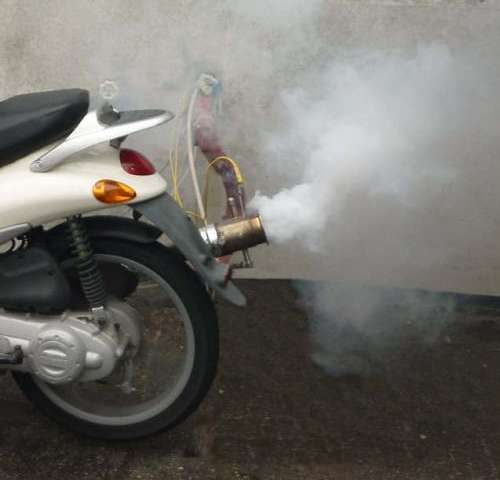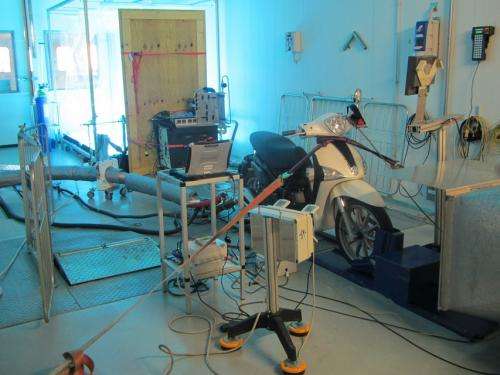In some towns, small mopeds cause more air pollution than cars

Not cars or trucks, but mopeds with their two-stroke engines are the main source of fine particles and other air contaminants in many towns in Asia, Africa and southern Europe. This is revealed by the study of an international research team headed up by researchers at the Paul Scherrer Institute PSI. The reasons for the high emissions are the combustion properties in two-stroke engines and the overly lenient emission requirements for small two-wheelers. The study findings are to be published on 13 May 2014 in the journal Nature Communications.
They are small, low in consumption and city-friendly but they are by no means ecologically harmless. Mopeds with two-stroke engines are at the top of the list of air polluters in some towns, mainly in Asia, Africa and southern Europe. This despite the fact that they account for only a fraction of total traffic volume. The suspicion that the two-wheelers, that are spared strict emission requirements, are the main contributors to air pollution in many cities has been around for a few years. Now an international research team headed up by the Paul Scherrer Institute has confirmed this suspicion with innovative measurement techniques.
The scientists used a smog chamber developed at PSI to measure the emission of organic aerosols and aromatic hydrocarbons from mopeds in the laboratory and in standard driving cycles. Organic aerosols are small particles which are suspended in air. They account for a major share of fine particles from traffic. By contrast, after being emitted as gaseous substances aromatic hydrocarbons (arenes) can be converted through chemical reactions in the atmosphere in part into secondary organic aerosols and, by extension, into fine particles. In fact, these secondary organic aerosols often account for the main proportion of fine particles. In their original gaseous form some arenes are harmful, too. Benzene, for instance, which is added to petrol is carcinogenic. The new study shows that during the conversion of exhaust gas from two-stroke mopeds other worrying products are formed. Using chemical analyses the scientists discovered that during the conversion of arenes from moped exhaust gases into aerosols, harmful reactive oxygen species are also formed which can reach the lungs.
High level of emissions even when not moving

Both when standing still and in motion mopeds with two-stroke engines emit amounts of arenes which are several orders of magnitude higher than the limit values admissible in Europe and the USA. According to the study authors, waiting behind a two-stroke moped in traffic may, therefore, constitute a considerable health risk.
The scientists list a number of possible reasons for these elevated emissions. Basically, these are old, well-known problems which are typical for two-stroke engines like incomplete combustion, the high ratio of fuel to air in the fuel mixture or the need to add the lubricating oil directly to the fuel. Problems of this kind only occur to a minor degree if at all with four-stroke engines.
Small fleet with a big impact
The new study shows that the conventional view that cars and trucks account for the lion's share of fine particles pollution from traffic will have to be revised, at least for specific regions. The researchers have calculated that in the Thai capital Bangkok two-stroke mopeds generate as much as 60 percent of emissions of primary organic aerosols. These two-wheelers only account for 10 percent of fuel consumption by traffic in the city. The calculations are based on the average emission factor of the European mopeds examined in the study. Hence, it probably underestimated the actual emissions of the mopeds circulating in Bangkok.
Ban with tangible results
Field measurements in China confirm the image of these rampant polluters on two wheels. In the city of Guangzhou the concentrations of arenes in the air fell by more than 80 percent in 2005 after a ban on two-stroke mopeds. Just 60 kilometres away in the city of Dongguan with its comparatively strict traffic restrictions, higher aromatic concentrations are measured today than in Guangzhou. The study authors report that in southern European towns the concentration of specific air contaminants could be considerably reduced if two-stroke mopeds were gradually withdrawn from circulation. The EU emission standard for two-stroke mopeds (Euro 2), which is also valid in Switzerland, dates back to 2002. For cars there are now far stricter requirements in Euro 5. From 2017 the EU will, therefore, introduce lower emission limits for small mopeds, too. Furthermore, more environmentally compatible alternatives are already available on the market like electrically driven mopeds which don't cause any noise pollution either. Mopeds with four-stroke engines, although not completely harmless, would be better than two-strokers.
More information:
phys.org/news/2014-05-two-stro … super-polluters.html
Provided by Paul Scherrer Institute